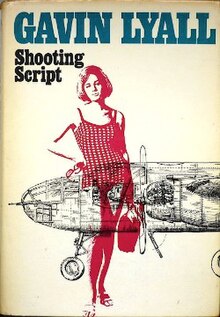
A night fighter is a largely historical term for a fighter or interceptor aircraft adapted or designed for effective use at night, during periods of adverse meteorological conditions, or in otherwise poor visibility. Such designs were in direct contrast to day fighters; fighters and interceptors designed primarily for use during the day or during good weather. The concept of the night fighter was developed and experimented with during the First World War but would not see widespread use until WWII. The term would be supplanted by “all-weather fighter/interceptor” post-WWII, with advancements in various technologies permitting the use of such aircraft in virtually all conditions.

A fighter-bomber is a fighter aircraft that has been modified, or used primarily, as a light bomber or attack aircraft. It differs from bomber and attack aircraft primarily in its origins, as a fighter that has been adapted into other roles, whereas bombers and attack aircraft are developed specifically for bombing and attack roles.
This is a list of aviation-related events from 1952:

The Bridges at Toko-Ri is a 1954 American war film about the Korean War and stars William Holden, Grace Kelly, Fredric March, Mickey Rooney, and Robert Strauss. The film, which was directed by Mark Robson, was produced by Paramount Pictures. Dennis Weaver and Earl Holliman make early screen appearances in the film.

The Most Dangerous Game is a first person narrative novel by English author Gavin Lyall, first published in 1964. The plot of the novel is unrelated to the Richard Connell short story "The Most Dangerous Game".
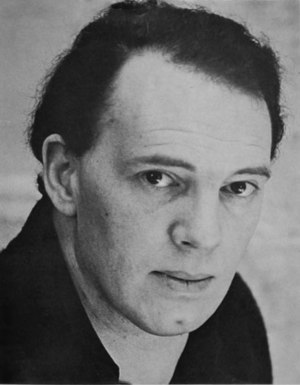
Gavin Tudor Lyall was an English author of espionage thrillers.

633 Squadron is a 1964 war film directed by Walter Grauman and starring Cliff Robertson, George Chakiris, and Maria Perschy. The plot, which involves the exploits of a fictional World War II British fighter-bomber squadron, was based on the 1956 novel of the same name by former Royal Air Force officer Frederick E. Smith, which itself drew on several real RAF operations. The film was produced by Cecil F. Ford for the second film of Mirisch Productions UK subsidiary Mirisch Films for United Artists. 633 Squadron was the first aviation film to be shot in colour and Panavision widescreen.

Piece of Cake is a 1988 British six-part television serial depicting the life of a Royal Air Force fighter squadron from the day of the British entry into World War II through to one of the toughest days in the Battle of Britain. The series was produced by Holmes Associates for LWT for ITV and had a budget of five million pounds.
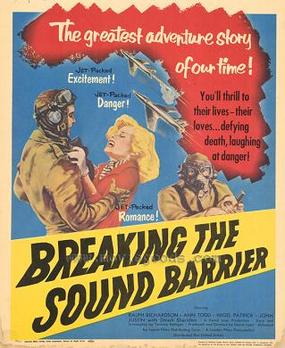
The Sound Barrier is a 1952 British aviation drama film directed by David Lean. It is a fictional story about attempts by aircraft designers and test pilots to break the sound barrier. It was David Lean's third and final film with his wife Ann Todd but it was his first for Alexander Korda's London Films, following the break-up of Cineguild. The Sound Barrier stars Ralph Richardson, Ann Todd, John Justin and Nigel Patrick. It was known in the United States as Breaking Through the Sound Barrier and Breaking the Sound Barrier.

Fail Safe is a 2000 televised broadcast play, based on Fail-Safe, the Cold War novel by Eugene Burdick and Harvey Wheeler. The play, broadcast live in black and white on CBS, starred George Clooney, Richard Dreyfuss, Harvey Keitel, and Noah Wyle, and was one of the few live dramas on American television since its Golden Age in the 1950s and 1960s. The broadcast was introduced by Walter Cronkite : it was directed by veteran British filmmaker Stephen Frears.
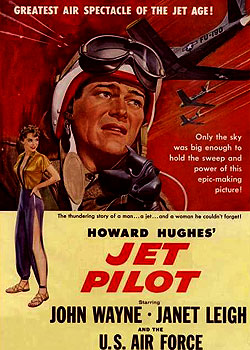
Jet Pilot is a 1957 American Cold War romance film directed by Josef von Sternberg and starring John Wayne and Janet Leigh. It was written and produced by Jules Furthman, and presented by Howard Hughes. Filming lasted more than eighteen months, beginning in 1949. The last day of shooting was in May 1953, but the Technicolor film was kept out of release by Hughes due to his tinkering until October 1957, by which time Hughes had sold RKO. Universal-International ended up distributing Jet Pilot.

The Spanish Republican Air Force was the air arm of the Armed Forces of the Second Spanish Republic, the legally established government of Spain between 1931 and 1939. Initially divided into two branches: Military Aeronautics and Naval Aeronautics, the Republican Air Force became the Air Forces of the Spanish Republic, also known as Arma de Aviación, after it was reorganized following the restructuring of the Republican Armed Forces in September 1936, at the beginning of the Spanish Civil War. This defunct Air Force is largely known for the intense action it saw during the Civil War, from July 1936 till its disbandment in 1939.

Command Decision is a 1949 war film released by Metro-Goldwyn-Mayer starring Clark Gable, Walter Pidgeon, Van Johnson, and Brian Donlevy, and directed by Sam Wood, based on the 1948 stage play of the same name written by William Wister Haines, which he based on his best-selling 1947 novel. The screenplay for the film was written by George Froeschel and William R. Laidlaw. Haines' play ran on Broadway for almost a year beginning in October 1947.
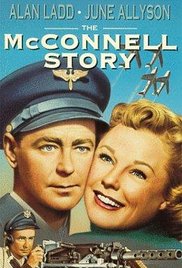
The McConnell Story is a 1955 dramatization of the life and career of United States Air Force (USAF) pilot Joseph C. McConnell (1922–1954) directed by Gordon Douglas. McConnell served as a navigator in World War II before becoming the top American ace during the Korean War and was killed on August 25, 1954, while serving as a test pilot at Edwards Air Force Base in the Mojave Desert, California. The Warner Brothers production, filmed in CinemaScope and Warner Color, stars Alan Ladd as McConnell and June Allyson as his wife. Longtime Warners staff composer Max Steiner wrote the musical score for the film.

Wings of the Navy is a 1939 American drama film directed by Lloyd Bacon and starring George Brent, Olivia de Havilland and John Payne. Like many of the Warner Bros. features in the pre-World War II era, it was intended to serve as propaganda for the U.S. military and received heavy support from the U.S. Navy, which also considered the film as a recruiting tool.
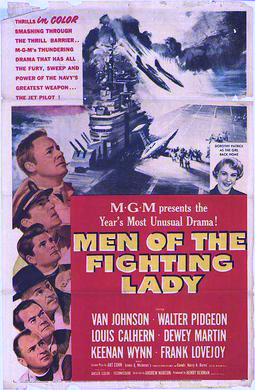
Men of the Fighting Lady is a 1954 American war drama film directed by Andrew Marton and starring Van Johnson, Walter Pidgeon, Louis Calhern and Keenan Wynn. The screenplay was written by U.S. Navy Commander Harry A. Burns, who had written a Saturday Evening Post article, "The Case of the Blinded Pilot", an account of a U.S. Navy pilot in the Korean War, who saves a blinded Navy pilot by talking him down to a successful landing. Men of the Fighting Lady was also inspired by another Saturday Evening Post article, "The Forgotten Heroes of Korea" by James A. Michener. The original music score was composed by Miklós Rózsa. It is also known as Panther Squadron. It is not to be confused with the 1944 documentary The Fighting Lady, which was mainly filmed aboard the USS Yorktown (CV-10).

Various real-world aircraft have long made significant appearances in fictional works, including books, films, toys, TV programs, video games, and other media.

Fort Wayne Air National Guard Base is a United States Air Force base, located at Fort Wayne International Airport, Indiana. It is located 7.6 miles (12.2 km) south-southwest of Fort Wayne, Indiana.
Sabre Jet is a 1953 American drama war film set during the Korean War, directed by Louis King and starring Robert Stack, Coleen Gray, Richard Arlen, Julie Bishop and Leon Ames. It was shot in Cinecolor using United States Air Force footage. Sabre Jet was based on a story by the producer Carl Krueger with the screenplay written by the husband and wife playwright and screenwriting team of Dale Eunson and Katherine Albert. The opening credits state: "This picture is dedicated to the air force wives who shared their men with a world made desperate by the most brutal aggressor in history."
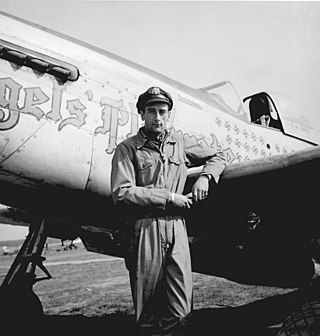
Bruce Ward Carr was a highly decorated United States Air Force colonel. During World War II, he was shot down over Germany and, after evading capture for several days, snuck into a Luftwaffe airfield and stole an enemy plane which he flew back to Allied lines. He also became a flying ace credited with 14 or 15 aerial victories, including five in a single day, for which he was awarded the Distinguished Service Cross.
